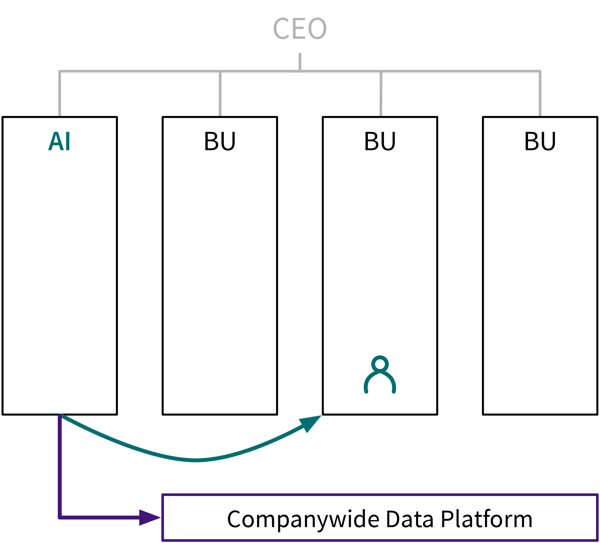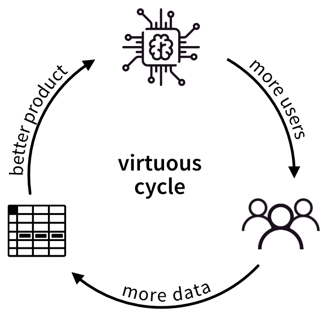AI Transformation of a Company
The famous ML researcher Andrew Ng has proposed a five-step process to transform your company into a data-driven enterprise capable of using AI in production to add value.
- [Step 1] Start with small pilot projects to understand the potential and challenges of using ML
-
Machine learning projects are unlike traditional software projects, where you’re usually certain that a solution at least exists and you only need to figure out an efficient way to get there. Instead, ML heavily relies on the available data. Even though it might theoretically be possible to solve your problem with ML, this might not be the case with the data you have at hand. Before implementing some big AI initiative spanning the whole company, it is therefore strongly recommended that you start with several smaller pilot projects in order to get a better feeling for what it means to rely on an AI to solve your problems.
When choosing a pilot project, the most important factor is not the Return on Investment (ROI) of the project, since here the experience with ML gained along the way should be the priority. However, it is important to choose a project that is technically feasible, i.e., which can be solved with existing ML algorithms and you don’t need years of research to develop your own fancy neural network architecture. Furthermore, you should have enough high-quality data available to get started, so you don’t spend months just on data preprocessing, e.g., due to the need to combine data from different sources within a poor data infrastructure.
If you do not yet have the necessary AI talent in-house to tackle such a project, you can also partner with external consultants, which provide the ML expertise, while you supply the subject matter expertise to ensure the pilot project is a success. - [Step 2] Set up a centralized AI team and data infrastructure to carry out bigger projects efficiently and effectively
-
We’ve already seen that in practice, it’s really about the intersection of Theory, Programming, and Domain Knowledge, i.e., Data Science. However, it is unlikely that you’ll find a single person that is truly competent in all three areas. Instead, people will always have a certain focus and we therefore propose three distinct roles, which also align very well with the three main steps for successfully executing an ML project:
 While Data Strategists work in their respective departments to identify suitable problems that can benefit from ML, Data Scientist can experiment and develop prototypical solutions to these problems, which Data & ML Engineers then get ready for production.
While Data Strategists work in their respective departments to identify suitable problems that can benefit from ML, Data Scientist can experiment and develop prototypical solutions to these problems, which Data & ML Engineers then get ready for production.Ideally, data scientists and engineers should be in their own separate team (i.e., the “AI Team”) and work on projects from different departments like an in-house consultancy:
 [Adapted from: “AI for everyone” by Andrew Ng (coursera.org)]
[Adapted from: “AI for everyone” by Andrew Ng (coursera.org)]This has several advantages:
-
Data scientists can discuss solutions with other ML experts → many problems will be similar from an algorithmic standpoint.
-
Combine data from the whole company for a holistic analysis.
-
Funding independent from individual business unit, e.g., necessary for the up front investment in data infrastructure, time required to keep up with new research, etc.
As we’ve discussed in the introduction, about 90% of the time in an ML project is spent on data wrangling. Therefore, especially in the beginning, the AI team should contain more Data Engineers than Data Scientists, so they can build a solid data infrastructure, which will save Data Scientists lots of time and headaches later.
-
- [Step 3] Train other employees to recognize ML problems and establish a data-driven culture
-
While data scientists need to be intimately familiar with the algorithms they are using, other employees, especially data strategists and department leaders, should have some basic understanding of what ML is and is not capable of, such that they can identify possible ML problems and refer them to the AI team.
 I have devised trainings at different levels for all audiences.
I have devised trainings at different levels for all audiences. - [Step 4] Devise a cohesive strategy with long-term goals that result in a competitive advantage
-
Developing a strategy might be the first impulse of an executive when confronted with a new topic such as AI. However, since AI problems are so different from other kinds of projects, it really pays off to first gain some experience with this topic (i.e., start with step 1!). After you’ve successfully completed some pilot projects and set the wheels in motion to create an AI team as well as educate the other employees to get them on board, here are a few things to consider w.r.t. a companywide strategy to give you an advantage over your competition:
-
Create strategic data assets that are hard for your competition to replicate:
-
Long-term planning: Which data might be valuable in the future? → Start collecting it now!
-
Up-front investments: What infrastructure and processes are needed to make the data accessible to the right people?
-
How can you combine data from different divisions to enable the AI team to “connect the dots” and gain a unique edge over the competition?
-
What options do you have in terms of strategic data acquisition, e.g., in the form of ‘free’ products, where users pay with their data (like what Google, Facebook, etc. are doing)?
-
-
Build AI-powered features that are a unique selling point for your products:
-
Don’t try to recreate some off-the-shelf service that could be easily procured from an outside vendor, but use ML together with your unique subject matter expertise and data to build new features for your existing products to make them more appealing to your customers or open up new market segments.
-
How can you establish a virtuous cycle, where your AI attracts more users, which in turn generate more data, which can then be used to train the AI to become even better and thereby attracts even more users?

-
-
- [Step 5] Communicate your success
-
After successfully implementing AI within the company, you should of course communicate your accomplishments. In addition to internal and external press releases, this also includes, for example, job listings, which will attract more qualified candidates if they are formulated from an informed standpoint instead of listing buzzwords.
